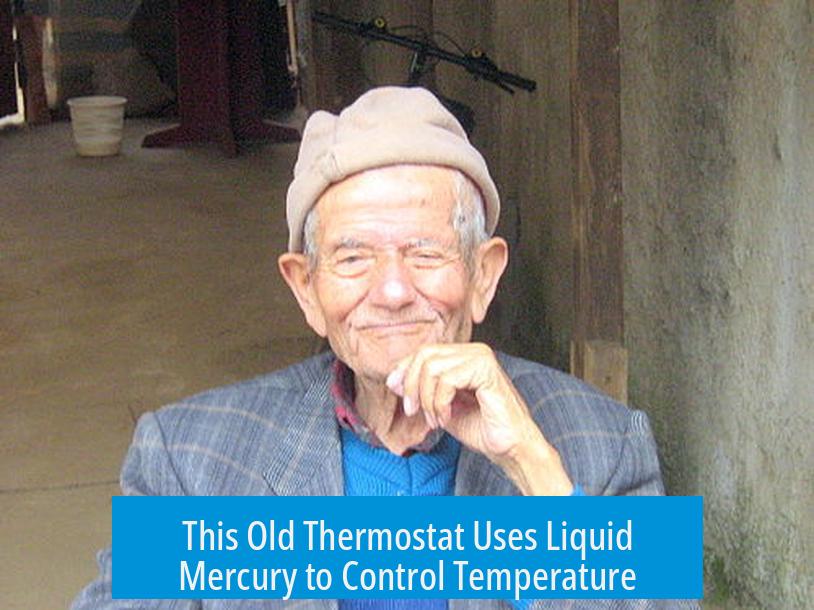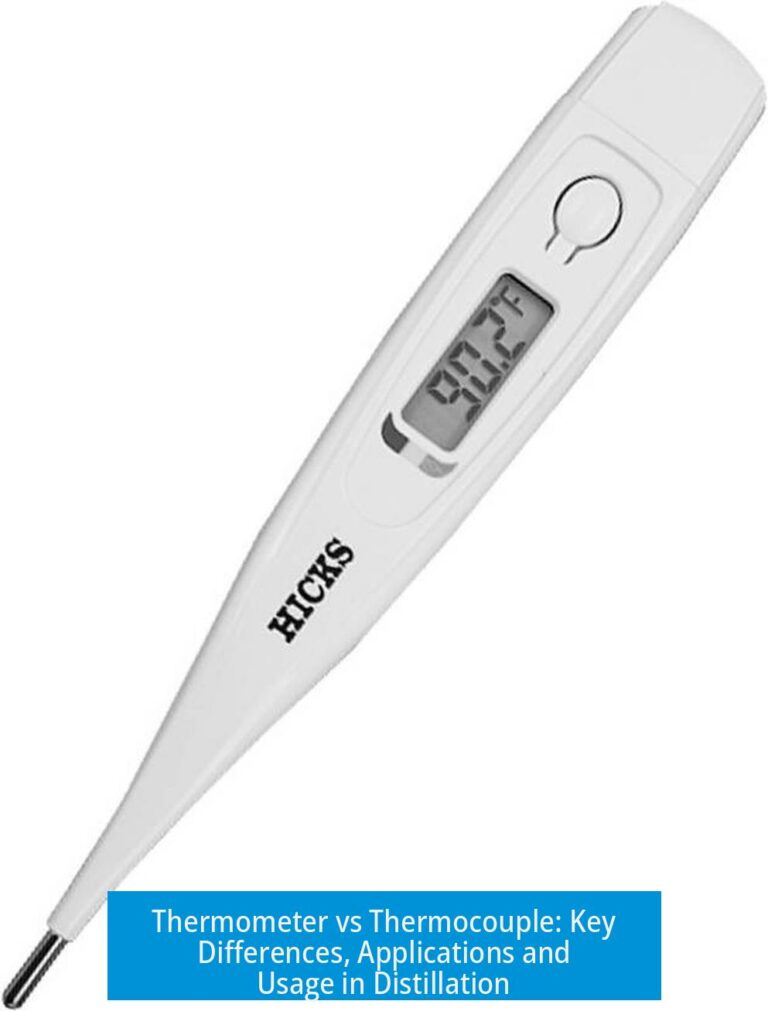This Old Thermostat Uses Liquid Mercury to Control Temperature

Old thermostats often employ liquid mercury within mercury tilt switches to regulate temperature. This design relies on a bimetallic coil that moves with temperature changes, causing mercury inside a sealed glass tube to tilt and complete an electrical circuit, engaging the heating or cooling system.
Mercury Tilt Switches: The Core Component

The essential part of these thermostats is the mercury tilt switch. It consists of a small amount of mercury sealed inside a glass tube, attached to a bimetallic coil mechanism. As temperature changes, the bimetallic strip coils or uncoils, altering its tilt.
When the strip reaches a preset temperature, it causes the mercury to slide and touch electrical contacts inside the tube, completing the circuit. This action either turns the furnace or air conditioner on or off by controlling the flow of current directly.

How Mercury Switches Work
- Mercury’s fluidity allows it to move freely within the tube, changing orientation based on the coil’s position.
- The tilt switch conducts electricity only in specific orientations, closing or opening the circuit accordingly.
- Low electrical resistance in mercury enables it to handle higher currents without overheating or burning out contacts.
This behavior made mercury switches reliable and efficient before electronic and digital controls became widespread.

The Temperature Sensing Mechanism
The temperature sensing element behind the mercury tilt switch is a bimetallic coil. It consists of two metals bonded together that expand at different rates when heated.

This differential expansion causes the coil to twist or untwist as the temperature changes. The tilt changes the position of the mercury level in the tube, turning the switch on or off at the designated temperature.
Reliability and Longevity

These mercury-controlled thermostats have proven highly dependable. The mercury is sealed in a nitrogen or SF-6 gas atmosphere to prevent oxidation, while contacts are platinum-plated to resist corrosion.
Many old homes, some built in the mid-20th century, still have functioning mercury thermostats. They do not require batteries or complex electronics, contributing to their long lifespan and stable performance.

Users often report better reliability with these compared to modern battery-powered or digital thermostats, which can fail or require frequent maintenance.
Historical Context and Shift to Modern Devices
Mercury thermostats were the standard for decades. HVAC technicians from 15 to 50 years ago commonly installed and serviced them.
Today, modern thermostats use electronic sensors or temperature transducers, measuring specific physical properties like resistance (R values) to detect temperature changes. These newer models offer digital control but can be less durable in some cases.
Safety and Environmental Notes
Mercury is toxic, which raises concerns about environmental safety if thermostats break or are improperly disposed of. Regulations now require special handling and recycling of old mercury thermostats.
Historically, mercury was salvaged from these devices for other uses. Its handling requires caution to avoid health hazards.
Physical Design Details
Some thermostats contain two separate mercury tilt switches to control heating and cooling independently. The arrangement may vary based on model and functionality.
Mercury switches were encased in robust glass with reliable gas seals, enhancing their durability and preventing mercury evaporation or contamination.
Cultural Reflections
Many people recognize mercury thermostats from their childhood or older homes. They symbolize early home technology advances and have nostalgic value.
Mercury thermostats also appear in popular culture, enhancing their iconic status.
Key Takeaways
- Mercury thermostats use a bimetallic coil to tilt a mercury-filled glass switch, completing or breaking an electrical circuit to control temperature.
- Mercury’s conductivity and fluidity provide low-resistance switching capable of handling higher currents efficiently.
- These thermostats are highly reliable, durable, and often remain operational decades after installation without batteries.
- Modern thermostats use electronic sensors but may lack the longevity of mercury-based models.
- Handling and disposal of mercury thermostats require care due to the toxic nature of mercury.
This Old Thermostat Uses Liquid Mercury to Control Temperature: A Glimpse into a Brilliantly Simple Yet Forgotten Technology
Imagine having a thermostat in your home that has been quietly working for decades without a single battery change, no fancy display, and no confusing programming menus. This old thermostat uses liquid mercury to control temperature. Yes, you read that right—liquid mercury sliding around inside a glass tube dictates when your heater kicks on or off. This might sound like a retro science experiment, but it was once the backbone of home temperature control everywhere.
Let’s dive into why these mercury thermostats were marvels of simple engineering, how they worked, and what makes them so memorable even today.
The Magic Inside: Mercury Tilt Switches and Bimetallic Coils
At the heart of these thermostats lies the mercury tilt switch—an ingenious little device where mercury, that shiny liquid metal, completes an electrical circuit when tilted enough. How does it work? It’s based on a bimetallic coil.
That coil isn’t just decorative; it’s made of two different metals bonded together. As the temperature changes, this coil expands or contracts, twisting ever so slightly.
When the ambient temperature reaches a preset point, the coil uncoils or coils enough to tilt a small glass tube containing mercury. The mercury, literally sliding down due to gravity, moves to complete an electrical circuit. This action sends the signal that completes the thermostat’s job: turning the furnace or air conditioner ON or OFF.
Mercury’s role isn’t just about being liquid metal. Its electrical conductivity is impressively reliable. Unlike mechanical contacts which can wear out or spark, the mercury switch maintains low ON resistance and can carry substantial current without burning out like open contacts might. For many homeowners, this meant a thermostat that just worked, year after year.
Reliability That Puts Modern Gadgets to Shame
Ever get frustrated with your fancy digital thermostat losing power or glitching during a power outage? Well, mercury thermostats laugh in the face of such troubles. These devices require zero batteries. The mercury is sealed in a protective atmosphere—either nitrogen or sulfur hexafluoride—to prevent corrosion or contamination. The contacts themselves are platinum plated, ensuring a beautiful marriage of durability and conductivity.
One seasoned HVAC technician confesses: “I do kind of snicker when I hear my family and friends bitching about the problems with their fancy digital thermostats. I’ve gone through four or five of those battery-powered gadgets and wish I still had mercury switched ones.”
And it’s not just an isolated opinion. Some homes built in the 1960s still sport their original mercury thermostats, still functioning like champs decades later. It’s a testament to the design’s longevity.
A Step Back in Time: The Era Before Digital Domination
Before temperature sensors became the norm, many buildings relied entirely on these mercury and bimetallic coil combos. They’re often called “mercury dip switches,” and they provided a foolproof way to manage temperature without complex electronics.
Technicians from the past reflect on this simplicity fondly. “Ingenious simple devices of yore,” one remarks, “completely abandoned nowadays in favor of temperature transducers that read ‘R values’ or some such fancy term.” There’s something refreshing about a device that measures temperature through pure mechanical movement and gravity.
Safety and Disposal: The Mercury Catch-22
Mercury isn’t without controversy. It’s toxic, which complicates how these old thermostats get disposed of. Unlike plastic gadgets, you can’t just toss a mercury thermostat in the trash bin.
One homeowner shares their dilemma: “I replaced my thermostat last year and now have one of these sitting in a drawer because I know I can’t just throw it in the trash lol.” Indeed, proper disposal is vital to prevent environmental contamination.
Interestingly, mercury’s unique electrical and physical properties have even inspired some unusual stories. For example, the IRA reportedly salvaged mercury switches from thermostats for use in bomb triggers and anti-tamper devices. Makes you think twice about the hidden history behind these seemingly mundane household items!
Why Two Mercury Switches? A Curious Question
If you’ve ever peeked inside one, you might notice two mercury-tilt switches or bimetallic coils instead of one. What’s the purpose? One explanation is redundancy and precision. Sometimes one switch controls heating, while another controls cooling or different circuit behaviors. Also, some coils may have only one mercury-filled tube depending on the function they perform.
Feel-Good Nostalgia Wrapped in a Retro Device
Mercury thermostats evoke warm memories for many. From childhood homes to the house your grandparents built, these devices were everywhere. One user said, “I’m 42, and they’re not so old, else I would be old. My house growing up had this.”
They call back to a simpler era—no frills, just dependable workhorse technology. For some, seeing a mercury thermostat sparks uneasy feelings (hello, Mercury is toxic!) but also a fond reminder of how things once were.
The Bottom Line: Should You Keep or Replace Your Mercury Thermostat?
There’s no denying the charm and reliability of mercury thermostats. If you’ve got one working in your home from the 60s, it may keep chugging along for some time. However, the mercury inside brings valid safety and environmental concerns today.
While modern digital thermostats offer convenience, smart home compatibility, and energy-saving features, they can be frustratingly short-lived or complicated for some users.
Here’s a practical tip: if you have a mercury thermostat, consider having it professionally replaced but safely store the old one until it can be recycled. Local hazardous waste programs often accept them. Keeping it around just to “maybe fix it later” probably isn’t safe.
When upgrading, look for solid-state thermostats with proven reliability or simple mechanical alternatives if you prefer no batteries or Wi-Fi dramas. Always balance safety, energy efficiency, and your lifestyle needs.
In Conclusion
This old thermostat uses liquid mercury to control temperature with a strikingly straightforward and effective design. Using bimetallic coils and mercury-based tilt switches, these thermostats achieved long-lasting, battery-free temperature control with exceptional reliability. While modern tech has largely replaced them, their legacy lives on among HVAC veterans and nostalgia buffs alike.
Have you ever encountered a mercury thermostat? Did it still work, or did it become a mysterious relic? Share your story and thoughts—you might just rekindle appreciation for this curious piece of technology history.
What role does mercury play in old thermostats?
Mercury acts as a conductive liquid in a tilt switch. When temperature changes, a bimetallic coil moves, tilting the mercury to complete the electrical circuit.
Why were mercury tilt switches favored over other types?
They have low resistance and can handle significant current without relays. Unlike open contacts, mercury switches don’t burn, making them very reliable.
How does the bimetallic strip work with mercury in these thermostats?
The bimetal strip coils or uncoils as temperature shifts. Once it reaches a set point, it tilts the mercury switch, activating the furnace by completing the circuit.
Are mercury thermostats still reliable today?
Yes, many old mercury thermostats still function well without batteries. The switches are sealed and have platinum contacts, which adds to their durability.
Why do some mercury thermostats have two tilt switches?
Often, multiple switches allow control of heating and cooling independently. Each switch activates a different circuit based on temperature changes.





Leave a Comment